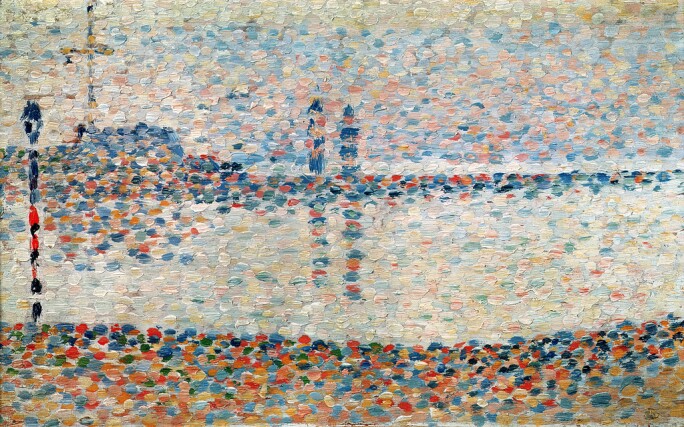
PUSHKIN MUSEUM OF FINE ARTS, MOSCOW, RUSSIA
Image: © 2021 Scala, Florence
A hypnotic synthesis of styles and vibrant hues, The River exemplifies the melancholic beauty and ethereal compositions that distinguish Matthew Wong’s remarkable oeuvre. Drawing upon masterpieces of the art historical canon and combining the dreamlike qualities of Georges Seurat and Vincent Van Gogh’s landscapes, Wong creates an entirely unique artistic vernacular that relies on an idiosyncratic handling of paint. Wong’s impastoed, painterly style is indebted to the nineteenth-century technique of pointillism championed by Neo-Impressionist painters Seurat, Paul Signac and Camille Pissarro. As critic Eric Sutphin asserts, “Wong can be considered a kind of nouveau Nabi, a descendant of Post-Impressionist painters like Édouard Vuillard and Paul Sérusier. Like his forebears, he synthesises stylized representations, bright colors and mystical themes to create rich, evocative scenes. His works, despite their ebullient palette, are frequently tinged with a melancholic yearning” (E. Sutphin cited in: Neil Genzlinger, ‘Matthew Wong, Painter on Cusp of Fame, Dies at 35’, The New York Times, 21 October 2019, online).


Musee de l'Annonciade, Saint-Tropez
Image: © Bridgeman Images Bridgeman Images
On the surface of the present work, fiery hues of red and cobalt coalesce in a composition that is at once abstract and figurative. From a distance, the impastoed blue brushstrokes form the vertical outline of a river as if seen from above. While Wong’s landscapes remain amorphous and abstracted, he often includes a single figure in the composition, minute compared to their expansive surrounding environment. In the present work, the figure is rendered with just a few quick brushstrokes, one arm outstretched as if caught in the act of swimming upstream. The sole figure at the top of the composition is juxtaposed against a deep green circular form towards the bottom, perhaps a small island in the riverbed, or a reflection of the moon. The emotional, chromatic and spatial complexities of the present work, populated by a solitary figure, inspire introspective reflection, the canvas seemingly encapsulating a surreal collective subconscious. As Sutphin explains, “At first I thought these complicated constructs of colour and pattern were spoiled by the single tiny person Mr. Wong drops into most of them… the figures’ rough, rudimentary drawing upsets the intoxicating ambiguity of the larger shapes like a false note, and their drastic difference in scale makes them hard to focus on. But in fact they’re both psychologically and formally crucial… And it’s only [the figure] who, by keeping the painting anchored however tenuously in figuration, gives its psychedelic pointillism the power to shock” (E. Sutphin cited in: Ibid.). In its nuanced balance between figure and nature, The River also recalls the radical sublimity of Caspar David Friedrich’s romantic landscapes, which often show a single figure profoundly regarding and reflecting upon the magnitude of nature.

Private Collection
Artwork: © ARS, NY and DACS, London 2021
Executed in 2018, only one year before the artist’s death at the young age of 35, the present work is an exquisite example of the profoundly vulnerable, hypnotic representation of the subconscious that characterises Wong's too brief and extraordinarily poignant oeuvre. Juxtaposing the vast expanses of blue and cadmium that appear to transcend the border of the canvas, the solitary recognisable human figure on the surface of The River enables the viewer to experience the picture directly, grounding the fantastical landscape in something universally relatable. Captivating in its exquisite serenity, the present work exemplifies the very best of Wong's highly celebrated practice, balancing between reality and the subconscious, fantasy and the figurative, while demonstrating the artist’s remarkable contribution to the storied tradition of landscape painting.